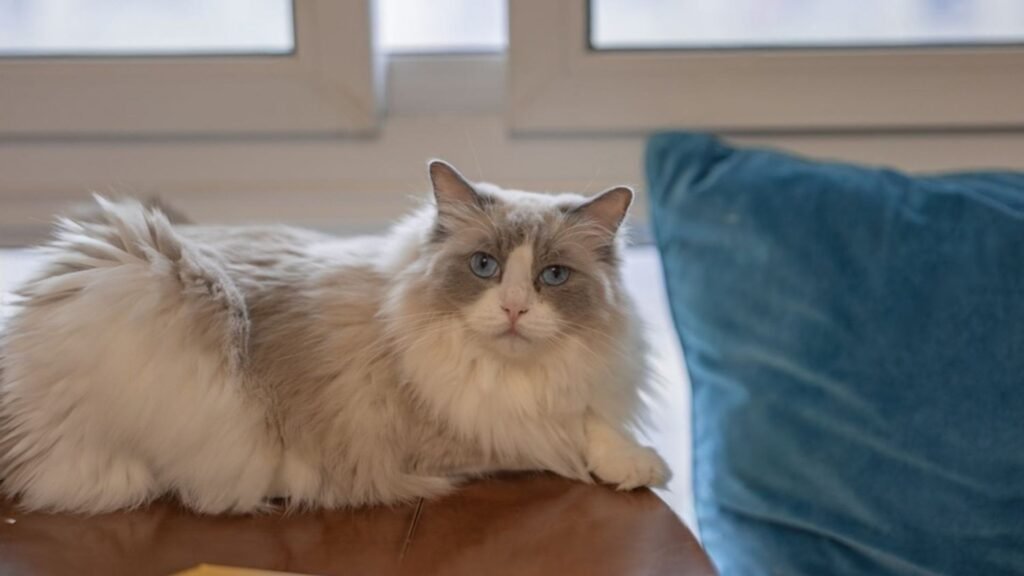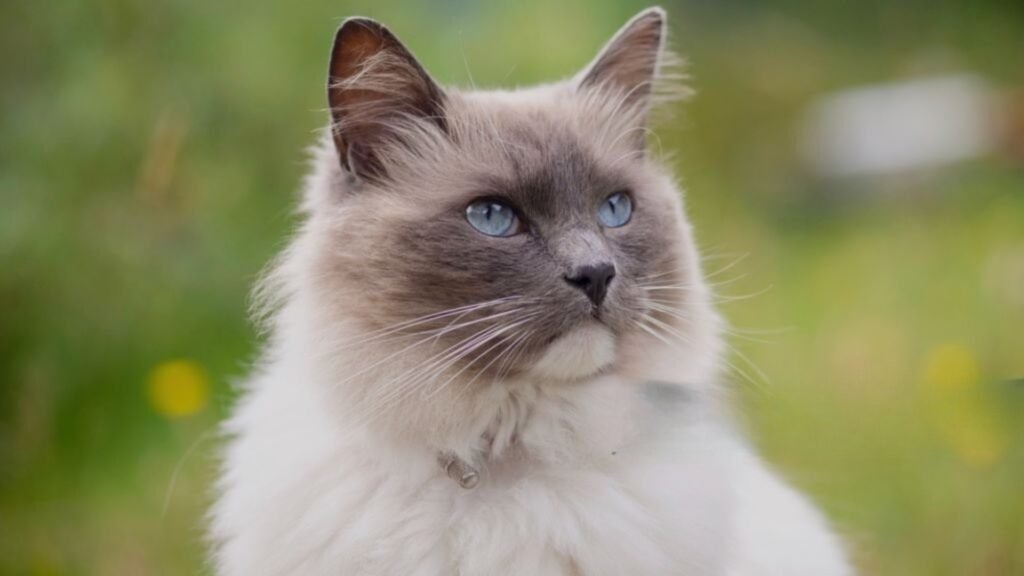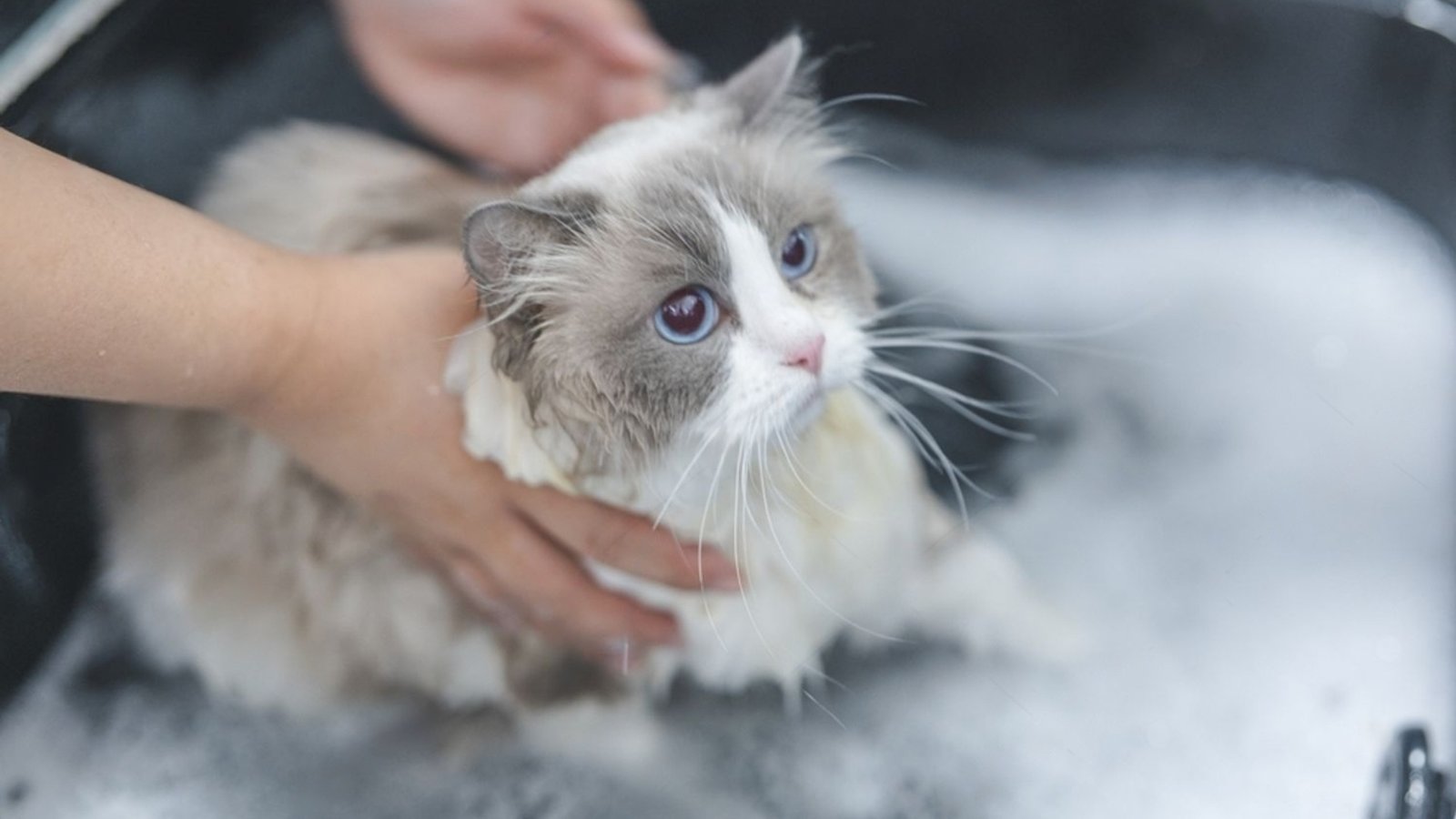You probably have heard about grey ragdoll cats, or perhaps you plan to bring one home. No surprise here, since grey ragdolls, logistically, are one of the most appealing felines to have around. They’d steal your heart with their calm, laid-back demeanor, bright blue eyes, and adorable appearance.
Technically, grey ragdoll, smokey grey ragdoll, dark or light grey ragdolls are all the fancy names used casually for blue point ragdoll cat because of their silvery-blue or bluish-gray hue. So, in reality, blue Ragdolls are the pedigree behind what many refer to as grey Ragdolls.
Whatever you call them, grey and white ragdoll cats are a stunning addition to your household, and obviously, their quiet grace makes every day a little brighter. Keep scrolling and get to know everything about the grey ragdoll cat! From her price to personality and genetics, you’ll get the full scoop here.
Related Read: Brown Ragdoll Cat
Grey Ragdoll Cat Breed Overview

History Of The Grey Ragdoll Cat
The story of the grey ragdoll kitten unfolded with Ann Baker of Riverside, Calif, who set out to make the ragdoll cat breed in the 1960s. She came from a Persian breeder background, though her vision took sharp shape when she had bred a white-colored longhaired female named Josephine. This cat had a seal mitted appearance similar to a Birman cat. Josephine was paired with Daddy Warbucks a sturdy seal-pointed male and later with a solid black male called Blackie under her personal care.
The offspring show off very gentle temperaments and would go all the way floppy when picked up. That’s what makes ragdolls so popular today. These cats also inherited the iconic pointed coat color and bright blue eyes. Over time, the silvery-blue hue of some kittens led them to be on paper called blue ragdolls, though many casually refer to them as grey ragdoll kittens due to their bluish-gray tones.
That’s how the term grey ragdoll stuck, even though breeders might technically classify them as blue. Ann Baker’s legacy lives on in these gentle cats whose history is as unique as their affectionate nature.
Grey Ragdoll Cat Personality & Temperament

If we talk about the grey ragdoll cat personality, they’re a masterclass in affection, with a temperament that feels almost dog like in their loyalty. They show a playful side when they wiggle across the floor or display goofy antics like sleeping in hilarious, uncanny positions (lol).
Unlike other high-energy cats, ragdoll grey cats aren’t so athletic, though they do like to chase a toy downstairs and then race back up just to plop beside you. You’ll find your grey ragdoll people-oriented and would rather nap on your lap or stay close to you than run off to hide. All the same, they’re never too aloof or demanding.
Because of their laid back, friendly personality, they’re exceptionally good with kids and other pets like dogs as long as your doggie behaves well and is in control. Ragdoll cats are not big fans of traveling, and neither is the grey ragdoll cat. We don’t think this thing could put anyone off, though.
Why Grey Ragdoll Cats are Often Confused for Blue Point Ragdolls
We have already talked lately that grey ragdoll cats often get mixed up with blue point ragdoll cats because their color patterns share a deep grey tone. Blue point ragdoll cats have a dark bluish grey hue that covers most of their body with deep gray-blue points on the face, snout, ears, limbs, and tail.
Officially, the blue color falls under pedigree ragdoll color and patterns backed by the Cat Francisers Association (CFA) and The International Cat Association (TICA), and not the grey color. Aside from the blue point ragdoll cat, sometimes blue bicolor, blue mitted, and blue lynx ragdolls are also casually referred to as grey ragdolls because of their light, though similar greyish tone.
Types Of Blue Ragdoll Cat Patterns Associated With Grey Cat Ragdolls
Blue Point Ragdoll Cat

The Blue Point Ragdoll or grey ragdoll cat sets itself apart with its silvery-blue primary coat color that covers most of their body. This bluish-gray tone blends into deeper gray-blue points on their face, ears, legs, and tail. Their mask-like facial pattern features darker blue coloration around the eyes and extremities, which gives them an almost mystical gaze. Although some might call them a dark grey ragdoll cat, their true charm lies in the cool undertones that shimmer like polished steel. The contrast between their pale bodies and rich points makes them a classic favorite among Ragdoll enthusiasts.
Blue Mitted Ragdoll Cat

The Blue Mitted Ragdoll Cat wins you over as a white and grey Ragdoll cat. We’ve a separate detailed guide on Blue Mitted Ragdoll Cats if you wish to check it out. Head-on, the only unlikeness you’ll pick up between this and the Blue Point is the mitted white feet. White “mittens” on their front paws and white “boots” on their back legs add a playful touch. Both the Blue Point Ragdoll and Blue Mitted Ragdoll stand proud as pedigree cats with colorpoint genes. These genes give off their darker points color while a lighter grey shade spreads all over the body. The mitted pattern adds extra sweetness with belly stripes. This light grey ragdoll cat feels like a cozy companion full of warmth and grace.
Blue Bicolor Ragdoll Cat

Blue Bicolor Ragdolls are rarely gets called grey ragdoll cats since most of their body color is white. They have medium-grade white coverage (40-60%) with points in darker grey (blue) on their ears, face, and tail. Their signature trait is an upside-down inverted “V” mask on the face, paired with a pinkish nose that adds a doll-like sweetness. The intensity of their blue color, however, fades towards the saddle (their back), and their chest, belly, and chin stay purely white. This gradient effect creates a dreamy contrast as if they’ve been lightly dusted with ash. Though not as overtly grey cats as other ragdoll blue patterns, their blue points still nod to the smoky elegance.
Genetics Of Grey Ragdoll Cat
The grey Ragdoll cat captures the hearts of their owners with their cute, innocent smile and sparkling coat color, though. All ragdolls, whether it’s mink, himalayan ragdoll mix, chocolate, or grey, start off completely white at birth. Then, around 2 weeks of age, the pointed coat color is coming in. The darkness of points and coat color depends mainly on genetics.
- Body temperature regulates the development of the coat color through a special gene. This temperature-sensitive colorpoint gene (cs) controls the darker shades that appear on the ears, face, tail, and legs. These areas, called points, define the grey Ragdoll kitten’s distinct look. The gene responds to cooler parts of the body, which explains why the points show up where they do.
- Now let’s break down the science. The base color of a grey Ragdoll hinges on three key genes. First, the colorpoint gene (cs) creates the contrast between the body and darker points. Second the dilution gene determines whether the Ragdoll kitten’s coat color stays non-diluted or becomes diluted. A blue grey Ragdoll cat occurs only when this gene is present in its double recessive dilution form (dd). This dilution takes the original seal color (a dark browny shade) and lightens it to that soft blue-grey hue everyone adores.
- Seal color is the base color here. If a Ragdoll has a BB genotype, it means they inherited the seal color gene (B) from both parents. When the BB gene combines with the dd dilution gene, the dark seal transforms into a lighter blue-grey tone. This genetic combo is why a blue point grey Ragdoll showcases that dreamy greyish-blue coat with slightly darker points.
How To Care For a Grey Ragdoll Cat

Nutrition
Grey Ragdoll cats are big, dog-like cats with a size that require a large portion of daily food to fulfill their nutritional needs. How many calories your grey Ragdoll cat specifically needs depends on how active she is, her age, and her health status. Ideally, aim for a daily calorie intake between 250-300 Cal. You can feed them wet food, or a mix of dry & wet. If you offer treats while teaching tricks, make sure these make up no more than 10% of their daily calorific intake. This balance keeps their diet healthy without overloading them with extras that would make them fat down the road.
Grooming
Since grey ragdolls have a medium to large coat with no undercoat, they’re less likely to shed heavily, though daily grooming is still necessary. Use a wide-toothed comb and a soft slicker brush to work through their fur all the way down to the skin. Focus on tricky angles where knots tend to form. Bathe your grey Ragdoll only after you’ve thoroughly combed their coat, and limit baths to once a month. Their fur stays fairly easy to care for with this routine. Trim their nails every other week and check their ears regularly to prevent wax or any sort of debris buildup.
Health Care
Grey Ragdoll care goes beyond grooming. Two common health issues to watch for are polycystic kidney disease (PKD) and hypertrophic cardiomyopathy (HCM). We strongly advise picking out a trusted vet ahead before bringing your grey cat home to establish a care plan. Keep them safe by getting rid of poisonous indoor houseplants and avoiding letting them outside if the temperature drops below 45°F. Even the toughest aren’t built for arctic chills or toxic spills, so a little prevention goes a long way!
Playtime & Exercise
Although ragdoll grey cats are medium energy felines that tend to sleep on the couch in front of the window all day, though. A healthy play session, even if it’s for 15 minutes, keeps them active and stress-free. Afterall, all they crave is our love and affection! Bring them some stuffed toys, balls, or wands, and rotate them every so often to keep things fresh and exciting for your grey ragdoll cat. One important tip: we hugely recommend not leaving your ragdoll alone for more than 8 hours a day, since this could stress your kitty out.
Grey Ragdoll Cat (FAQs)
How Much Does a Grey Ragdoll Cat Cost?
Since blue grey ragdoll color and pattern isn’t rare, you can easily find a registered, vaccinated kitten for somewhere around $2500 to $5000. On the flip side, adoption is far less expensive as long as you’ve found the right shelter or rescue center. It’s much more affordable than buying one. If you go for a rescue ragdoll, expect to pay anywhere between $400 to $1000. This likely includes spaying or neutering, getting their first round of vaccines, and microchipping for ID.
Where To Find Grey Ragdoll Kittens?
To get a healthy and ethically raised grey ragdoll cat, look out for reputable breeders in your area. Over and above, you can search online for registered breeders in the Cat Francisers Association (CFA) site or ask for recommendations from your friends, family, or local vet.
Does a Grey and white Ragdoll Cat Make a Good Pet?
Yes, it does. A Grey Ragdoll Cat in fact makes an excellent pet. They’re super affectionate and have very laid-back personalities that’ll melt your stress away in no time! Besides, if you’ve respected kiddos and well trained pets, they’d get along just fine. Whether you live solo or with a lively crew, they adapt and fill your home with warmth as long as they get the affection and love they need from their humans.
Wrapping Up…
All in all, grey ragdoll cats, with their bluish grey coat, bright blue eyes, and adorable personality, capture any cat fanatic’s heart at first glance. These felines have a way of melting into your life. Their unique genetics give them that elegant look, while their easygoing grooming needs make them a joy to have around. Grey is a fancy name used for a blue point ragdoll kitten because of their diluted bluish-gray (officially called “blue”) points and a cooler-toned hue. If you’re dreaming of a fluffy, floppy feline who combines grace with a loving soul, a Grey Ragdoll cat might just be the one to totally win you over and curl up by your side for years to come.
Written By: Usman Malik | Reviewed By: Ali Abbas | Fact Checked By: Aqib Zulfiqar




